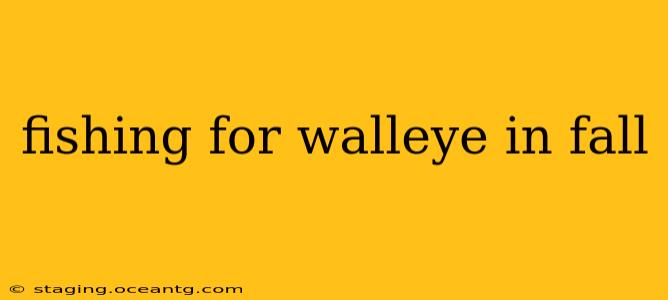Fall is arguably the best time of year to target walleye. As the water cools and the days shorten, walleye become more active and concentrated, providing anglers with excellent opportunities for trophy catches. This guide will equip you with the knowledge and strategies needed to maximize your success fishing for walleye during the autumn months.
Why Fall is Prime Walleye Time
The changing seasons bring significant shifts in walleye behavior. Cooler water temperatures trigger a feeding frenzy as they prepare for winter. This increased activity makes them more susceptible to a variety of fishing techniques. Plus, the vibrant fall foliage provides a stunning backdrop for an unforgettable fishing experience.
Where to Find Fall Walleye
Locating walleye in the fall requires understanding their habitat preferences as water temperatures drop.
H2: What are the best locations for fall walleye fishing?
Walleye will transition from their summer haunts to deeper water as the water cools. Look for these key areas:
- Deep water structures: Focus on areas with structure like reefs, drop-offs, humps, and submerged weed beds. These offer walleye protection and ambush points for prey.
- Points and shorelines: As the water cools, walleye will often relate to points and shorelines that extend into deeper water. These locations provide easy access to both shallow and deep water.
- River channels: Walleye often congregate in deeper river channels during the fall, seeking the slower, deeper current.
H2: What depths should I fish for walleye in the fall?
Depth will depend on water temperature and specific location. As a general rule, expect walleye to be found in deeper water than during the summer months. Start your search in depths ranging from 15-30 feet, but be prepared to explore deeper if necessary. Use your depth finder to locate fish and structure.
Effective Fall Walleye Fishing Techniques
Several techniques excel during the fall walleye season. Experiment to discover what works best in your chosen location.
H2: What are the best lures and baits for fall walleye fishing?
Walleye feeding patterns change in the fall. While live bait remains effective, lures often entice aggressive bites. Consider these options:
- Jigging: Jigging with minnow or plastic grub is a highly effective technique. Varying your jigging action can trigger strikes.
- Cranking: Deep-diving crankbaits mimicking the movements of baitfish are excellent choices. Experiment with different colors and retrieve speeds.
- Trolling: Trolling with crankbaits or spinnerbaits covers large areas efficiently. Vary your speed and depth to locate the fish.
- Live bait: Slip bobbers with minnows or leeches remain a reliable option, particularly in shallower areas.
H2: What is the best time of day to fish for walleye in the fall?
While walleye are more active throughout the day in fall, dawn and dusk remain prime fishing times. Low light conditions often trigger increased feeding activity.
H2: What are some tips for successful fall walleye fishing?
- Pay attention to water temperature: Cooler water means slower walleye metabolism and potentially slower bites. Adjust your techniques accordingly.
- Use your electronics: A depth finder is crucial for locating fish and structure. Side-imaging sonar can be particularly helpful.
- Be patient: Fall walleye fishing can require patience. Don't get discouraged if you don't immediately find fish.
- Experiment with different techniques and presentations: What works in one location might not work in another. Be adaptable and willing to try new things.
- Dress warmly: Fall weather can be unpredictable. Dress in layers to stay comfortable and safe.
Conclusion
Fall offers a unique and rewarding walleye fishing experience. By understanding walleye behavior in the fall, choosing the right locations, employing effective techniques, and being patient, you can significantly increase your chances of a successful and memorable fishing trip. Remember always to practice responsible fishing and adhere to local regulations.
